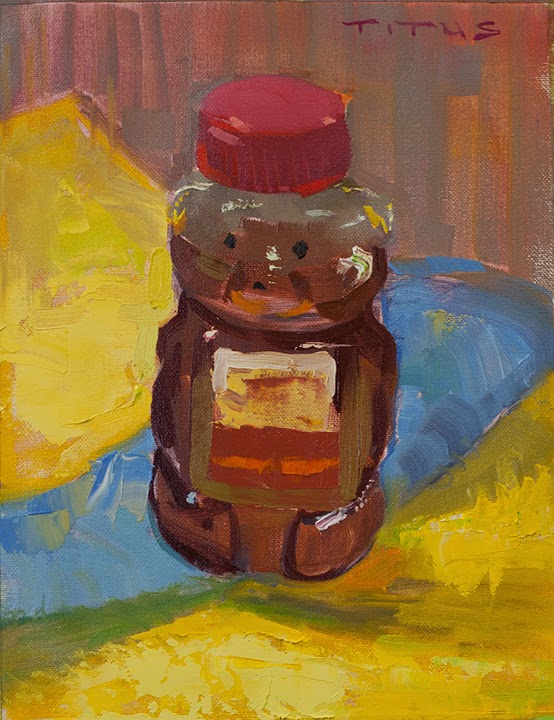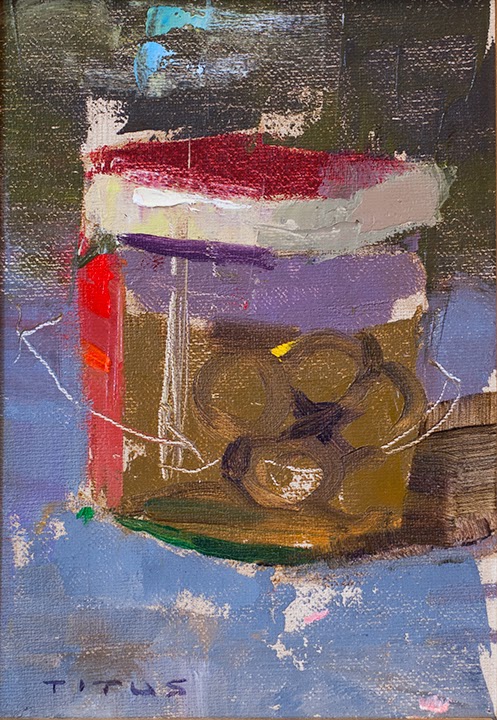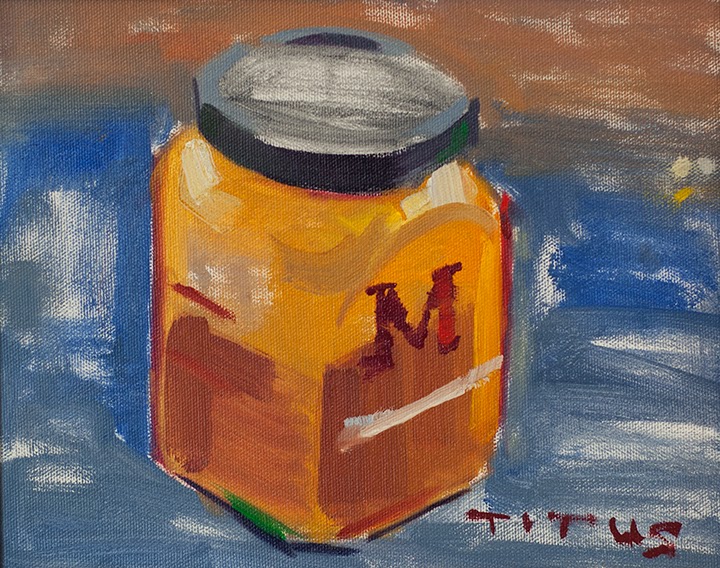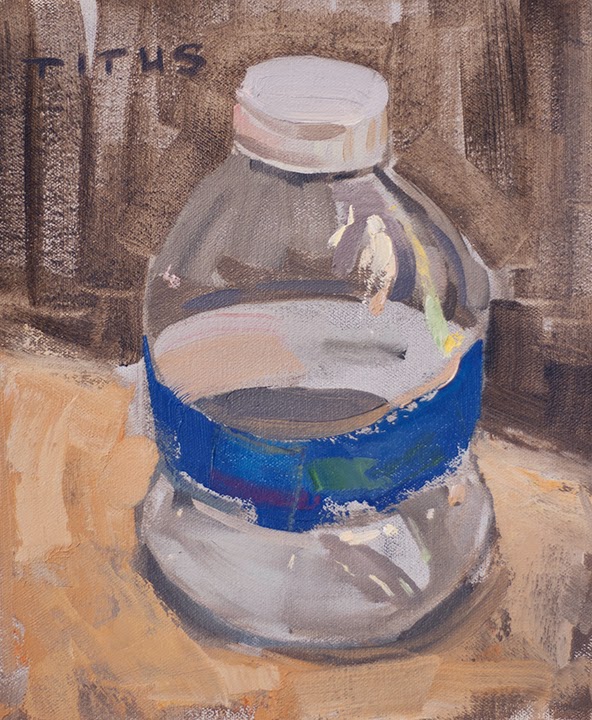Wednesday, October 29, 2014
Structural planes
As a painter, it's important to see objects as being constructed with flat planes, or structural planes. Often, as a student, its a common bad habit to thoughtlessly blend your strokes over and over again. This exercise will help you see the overall structural mass of an object and help you to not over-blend when building an object. It will dictate the direction of your brushstrokes, help you simplify values without blending, realize the source/direction of the light source and help you understand the object as it appears in perspective. In this exercise, I observed an apple and imagined how it would look being constructed entirely of flat planes. To help me do this, I envisioned what it would be like to sculpt this apple out of a block of clay using a knife. By being forced to make edgy deliberate strokes with a flat brush and not allowing myself to blend (especially a round object such as this apple), I could better make thoughtful shapes that had purpose. Now, imagine what it would be like to apply these principles to a face or head.
Understanding how tone affects color
This is a valuable exercise that uses only gray with a given color. It is interesting to see how gray (Titanium white and Ivory black) affects color. A variety of tones are created depending on how much black vs. how much white is in the gray mixture. I recommend doing these tone charts with all colors on your palette (primary and secondary colors). I also recommend doing these charts again with using brown instead of black. Also, note how cadmium yellow is light in nature and appears higher up on the value scale. By the same token, Cadmium red is intrinsically a darker color and appears lower on the value scale. Be sensitive to the innate lightness or darkness of a color that comes directly out of the tube. Because of this, cadmium yellow can sometimes be used to lighten a color–just as, Ultramarine can be used to darken a color. Helpful Tip: try printing-out (in black and white) any color, stripping it of its color information to see where exactly it would fall on the value chart.
Class demo
This portrait demonstration of a live model utilizes the two principles: building an object seeing structural planes and using tone with color.
Thursday, June 19, 2014
Artist quote of the week.
"A sandwich is not much a sandwich at all if it doesn't include but all the basic food groups, and art." -Titus
Sunday, June 15, 2014
Be the genius you are now.
 |
| Titus Castanza fishing, photo by Alec Laughlin |
An artist may become disappointed to discover that they are not the kind of artist he/she had originally set out to be. If the journey is to have any amount of sincerity or originality, then the artist's voice from within reveals itself to the artist, not the other way around. For the most part, the author is born with his/her unique smell. The error in an artist's way is when he/she attempts to emulate current standards or trends to any certain degree of esthetic which aren't entirely their own. A certain esthetic or affect is often adopted by the author, masking his/her own originality and resulting in insincere results.
Art should be conceived without ulterior influence, to the utmost extent possible. An artist only needs to exude their own natural given smell and to not mask it by splashing on cologne, so to speak. Simply put, all we have to do is just be ourselves, as hard as that may sometimes be.
Cezanne realized the importance of keeping his artist core intact from a young age. He believed that the influences of school and gallery shows were to be avoided. He made his art unto himself, allowing it to evolve in its own kind of personal vacuum with as few distractions as possible, so that it could evolve unhampered over his lifetime. He was a provincial man who chose the seclusion of the countryside over the bustling opportunities of the city–he rejected criticism and fame.
 |
| Paul Cezanne, self portrait |
Another motivation realized may be that becoming more technically proficient in rendering realistically may not be nearly as important as the artist had once thought. It's only but one tool in an artist's arsenal. An artist may realize that idea is more important–to develop a philosophy on how art and life is to be expressed. Idea becomes the trumping force, away from the technical. Expert levels of technical skill may be obtained and used, but only if to strengthen the artist's argument or to help give idea greater impact. Thus, the amount of technical skill needed is subject to idea.
Picasso for instance, a brilliant draftsman who figured out his path and became famous for it, but it wasn't for his technical proficiency–quite the opposite. The impact of his ideas for the non-literal far trumped his ability to render realistically. It was as if he had unlocked his child genius and left realism behind. This is probably why he is quoted as saying,
"All children are artists. The problem is how to remain an artist once he grows up. "
"It takes a long time to become young." -Pablo Picasso
It was ultimately their personal expression which took them further. I wonder how much longer I must toil before my artist self is fully realized. Will I be 50, 70 or 90... or dead?
-Titus
Monday, May 26, 2014
Painting from sketches...
 |
| Painting done in studio from sketchbook drawing |
 |
| Value study done on computer |
 |
| Original drawing done on location |
Wednesday, May 14, 2014
Yurmby Color Wheel
Here's the Yurmby color wheel, approximately 12 x 12 inches in diameter. A valuable exercise in toning the colors on your palette. I used the primary colors on my existing palette including magenta and cyan. All you need to do is progressively add more gray to each color step as it approaches the center of the wheel. The middle value gray dot used in the center of the wheel is the same value gray I used to tone all the colors. Colors I used: Y=cadmium yellow pale, R=cadmium red, M=Permanent Magenta, B=French Ultramarine, C=cyan (manganese blue phthalo), and G=cyan+cad yellow pale. You will find that mixing your batches of paint with a palette knife is critical, you will build a sensitivity to how value alone affects color and you will also learn to be more organized when mixing batches of paint on your palette.
Here's a great website created by Richard Robinson and offers an interactive color wheel where you can create your own gamut masks in virtual reality!
http://www.livepaintinglessons.com/gamutmask.php
Here's a great website created by Richard Robinson and offers an interactive color wheel where you can create your own gamut masks in virtual reality!
http://www.livepaintinglessons.com/gamutmask.php
Friday, April 18, 2014
Collecting Your Own Reference
Collecting your own reference opposed to using someone else's is a sacred part of an artist's process. Without it, you are missing-out on a multitude of factors including emotional content. If you want to go beyond your reference you must experience the thing first-hand. For example, by taking this photo myself I had the opportunity to experience the moment and all its immeasurable details. I became intoxicated by the event, smelt the horses, felt the thumping of their hooves, heard the sounds of the crowd, befriended the culture, placed my bets on the horses and so-on and so-forth. Not to mention the experience as a whole gave me an invaluable sense of time and place. A true human experience. An experience that created a story which sounds more like a bundle of emotions than just an account of events. Life is art and art is life. And so, your life and your life's experiences collectively make-up your art. This emotional content gathered from the experience of living is what makes art so powerful and is very much irreplaceable. If you want to make good art, profound art, then I suggest taking-in and experiencing as much of life has to offer... then make it.
Class demos
 |
| Honey Bear, 10x8 inches |
 |
| Jar of Olives, 7x5 inches |
 |
| Marmalade, 8x10 inches |
 |
| Water Bottle, 10x8 inches |
Wednesday, March 5, 2014
Friday, January 17, 2014
Techniques for getting yourself painting again.
You're in that rut? That's not good.
Well, there's quite a lot you can do to get out of the rut if you put your mind to it. When I get like that I like to think about painting as something that is done for fun, for your enjoyment only and for pure leisure and escapism. Certainly don't make a big deal about the whole act and don't worry about rules or approaches that must be done. Your critic must be dissolved. Paint as if no one will ever see the painting. Anything you do will be received with great celebration by yourself. Paint using your child instincts and purely for the enjoyment of the act itself. Every stroke is a very fulfilling exploration of yourself and the thing your painting. If you paint trusting your child-self, where you are the only one with all the answers you'll ever need, then your artist voice will start to take over.
I also try to relax, experience life and think about things that inspire me to want to paint. They may be philosophies, inventions, people, places or things from my imagination. I draw a lot and develop this conversation in my sketchbooks. Paint or draw simple things or take complicated things (compositions) and make them simple.
I like to think of the things that I like and why I like them. Thinking about why you like something leads to greater awareness and deeper investigation.
Try writing. Write in your sketchbook or journal. Creating a blog for your artwork is a great place to focus on writing about your art in-depth. Writing helps me keep a dialog going about where I'm at with my art, the way I see the world and understanding my journey.
Try teaching. Show someone else whether a child or a classroom full of adults what you know about drawing, painting, sculpture or art in general. Verbalizing out loud what you know in front of an audience helps you make clear to yourself and others your approach and ideas about painting. You will also find that you will not have time for negativity and your critic will begin to dissipate.
Record your dreams immediately upon waking. Write down in detail in your journal or do a quick sketch in your sketchbook. You will surprise yourself. Your dream-inspired sketches are a more honest interpretation of your unsolicited inner voice.
Try writing. Write in your sketchbook or journal. Creating a blog for your artwork is a great place to focus on writing about your art in-depth. Writing helps me keep a dialog going about where I'm at with my art, the way I see the world and understanding my journey.
Try teaching. Show someone else whether a child or a classroom full of adults what you know about drawing, painting, sculpture or art in general. Verbalizing out loud what you know in front of an audience helps you make clear to yourself and others your approach and ideas about painting. You will also find that you will not have time for negativity and your critic will begin to dissipate.
Record your dreams immediately upon waking. Write down in detail in your journal or do a quick sketch in your sketchbook. You will surprise yourself. Your dream-inspired sketches are a more honest interpretation of your unsolicited inner voice.
Listen to music. Listening to music while you create or while you're not creating is a great engine. This usually gives way to me reasearching new and existing bands.
And, when I'm really at a road block in life, I like to listen to Gene Wilder's song, "Pure imagination":
Or, I'll try having a drink of beer or three. I'll listen to music and find new musicians that inspire a different state of mind or emotion. I also like spoken books or recordings of rants by artists, writers and poets.
I'll hang out with other artists and talk about art or things that inspire them. I like to hear their perspective and how they see things. I find their points of view are usually more optimistic than my own, and optimism, usually leads to greater in-depth thinking and discovery.
I'll work out at the gym or at home (but usually not while drinking). Practicing Yoga or just plain stretching can be a great way to awaken the muscles and refresh your physical body. And, having a moment or two through out each day to meditate--or really, just call it whatever you want. I like to call it listening and feeling the sun on my skin.
Read a book. I like to read many books on artists that talk about their life and art. I like to read whatever... Hemingway, F. Scott Fitzgerald, Kurt Vonnegut, or even a self help book about greater consciousness and awareness. The book I'm reading now is a book by Jon Kabat-Zinn, Wherever You Go There You Are. It talks about non-doing.
When I'm not quite in the mood to actually make art, I'll do things that are related to enabling the act. I'll build stretcher bars, stretch canvas, build frames, clean glass on existing pieces, take pictures of them or scan them, cut mat board, clean and organize my studio, or even shop for supplies online or in stores.
Collect reference. I bum around and take pictures with my camera of things that I like (buildings, people, whatever). I may even do a quick sketch of it as a way of documenting it as well.
Go for a hike and sketch along the way. Sketching isn't always necessary, sometimes just "taking-in" is all that is needed.
I also like to do non-art related activities, such as: fixing my car or house, cleaning my car and truck, studio or house, or doing something nice for someone else.
Go to museums or galleries where you can see the original works of art. I like to feel the energy the originals have, especially Rembrandt's. I also go to local art shows and gallery openings to support other artists.
I find that planning out my projects that I am going to work on sometimes helps. Having a clear picture of what you plan on setting out to do such as a series can help motivate you and steer you in a direction.
Go on Youtube and watch artists paint their pictures.
I find that planning out my projects that I am going to work on sometimes helps. Having a clear picture of what you plan on setting out to do such as a series can help motivate you and steer you in a direction.
Go on Youtube and watch artists paint their pictures.
I'm usually always researching obscure artists so that I may find a language that resonates with my own. I recently found an artist that I really like, Arthur Clifton Goodwin. In these, I look for new inspiring approaches that lead me to the sheer joy of painting.
Try looking at this great blog that I recently found. There are many great artists I've never even heard of and I'm sure they all went through the same tribulations.
http://bjws.blogspot.com
Also, don't forget to get proper amounts of sleep and nutrition. Sleep greatly affects creativity. It's one of the first things I check when I'm in a rut or depressed for that matter. I ask myself, Have I had something to eat? Have I been drinking water? Have I gotten my eight hours of sleep?
Also, don't forget to get proper amounts of sleep and nutrition. Sleep greatly affects creativity. It's one of the first things I check when I'm in a rut or depressed for that matter. I ask myself, Have I had something to eat? Have I been drinking water? Have I gotten my eight hours of sleep?
Subscribe to:
Comments (Atom)







